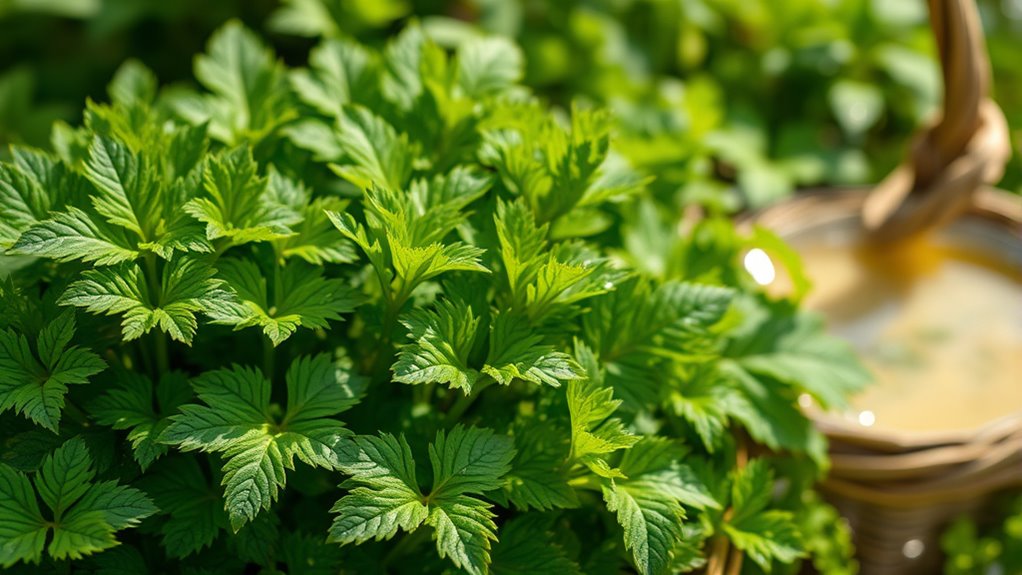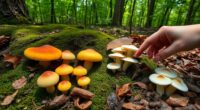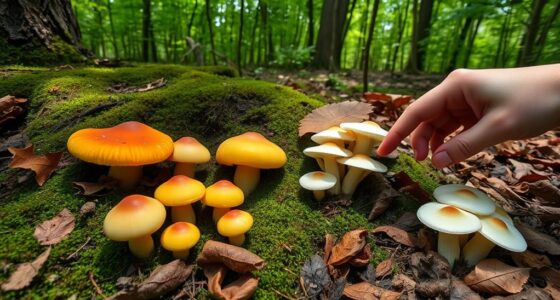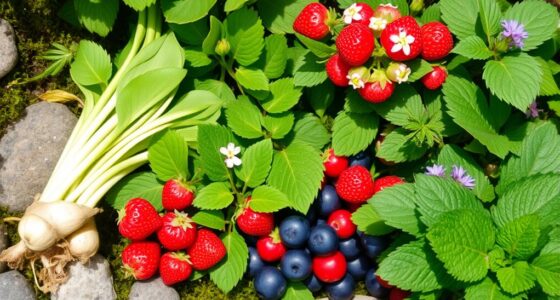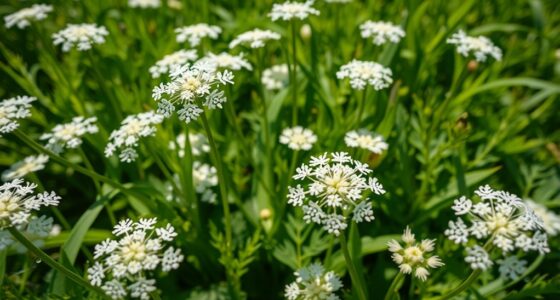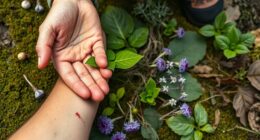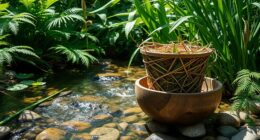Nettle foraging is a fantastic way to boost your health with nutrient-rich greens packed with vitamins, minerals, and antioxidants. When harvested carefully with gloves and proper identification, nettles can be safely enjoyed after boiling or cooking to neutralize their sting. From soups and pesto to teas, there are many tasty ways to incorporate them into your diet. Stay cautious during harvesting and preparation to enjoy all their benefits, and discover more nutritious recipes ahead.
Key Takeaways
- Nettle is nutrient-dense, rich in vitamins, minerals, antioxidants, supporting immune health and reducing inflammation.
- Proper harvesting involves wearing gloves and cooking or blanching to neutralize stinging hairs and ensure safety.
- Young, tender nettle leaves can be used in soups, pestos, teas, and omelettes after thorough cleaning and cooking.
- Foraging sustainably by leaving enough plants and avoiding polluted areas helps protect ecosystems and ensures safe consumption.
- Incorporating nettles into your diet can boost bone health, improve digestion, and promote healthy skin and hair.
Identifying and Harvesting Nettle Safely
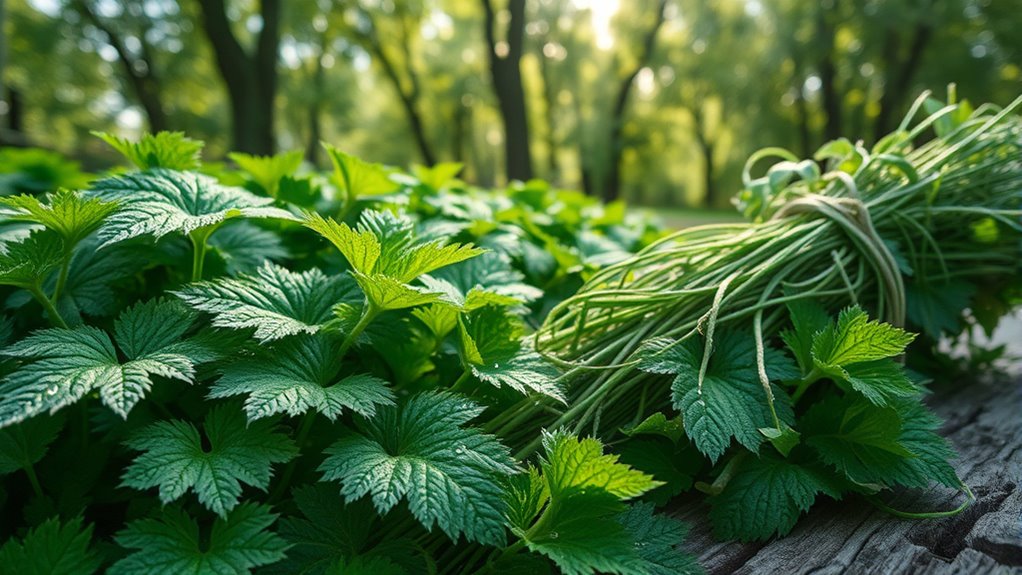
To identify and harvest stinging nettle safely, you need to recognize its distinctive features and use proper techniques.
Stinging nettle is a perennial herb with a square stem, similar to mint, and opposite, deep green leaves with serrated edges. The leaves are often several inches long, coarsely toothed, and pointed, with younger leaves appearing more heart-shaped. Understanding plant anatomy can help in distinguishing stinging nettle from look-alikes and ensure safe harvesting practices. Additionally, familiarizing yourself with its plant habitat can help locate healthy, sustainable plants for foraging. Being aware of the plant’s growth cycle can also guide optimal harvesting times for the best nutritional quality. Recognizing the distinguishing features of nettle ensures accurate identification and prevents accidental harvest of similar-looking, non-edible plants.
Stinging nettle is a perennial herb with square stems and serrated, heart-shaped leaves.
Its notorious sting results from trichomes injecting formic acid and histamines into the skin.
Nettle prefers damp, nitrogen-rich soils near rivers, streams, and old farmsteads. To avoid misidentification, be cautious of plants like clearweed, which lacks stinging hairs, and wood nettle, which is edible but different.
Always wear gloves and use scissors for harvesting, especially during early spring or late fall, to prevent skin irritation. Furthermore, understanding the details of plant anatomy can aid in proper identification and safe collection practices.
Exploring the Nutritional Composition of Nettle
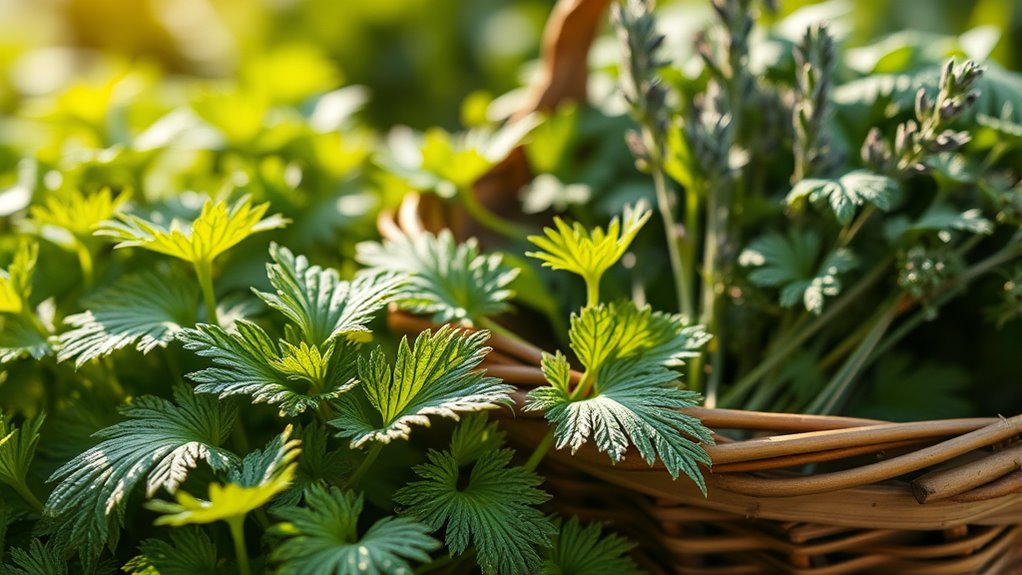
Nettle is a highly nutritious wild plant, offering an impressive array of vitamins, minerals, and bioactive compounds. It’s low in calories, with about 37 per cup of blanched leaves, yet packs a protein punch—up to 26% of its calories come from protein. You get about 6.1 grams of fiber per cup, supporting digestion.
Its mineral profile is rich, especially in calcium, iron, magnesium, and potassium, often surpassing dairy in calcium content. Nettle also provides vitamins A, C, and E, boosting your immune health and vision. Additionally, it contains flavonoids, phenolic acids, carotenoids, chlorophylls, and omega-3-like linolenic acid, all contributing antioxidant and anti-inflammatory benefits. This diverse nutritional makeup makes nettle a versatile and powerful addition to your diet. Historical use of seeds highlights how seed-based diets have contributed to health and longevity, similar to the benefits found in nettle consumption. Incorporating nutrient-dense foods like nettle into your meals can optimize your overall well-being and support long-term health. For example, bioactive compounds in nettle enhance its health-promoting properties and contribute to its reputation as a superfood. Understanding plant-based nutrition helps appreciate how natural foods like nettle can improve health outcomes through their complex nutrient profiles.
Health Advantages of Incorporating Nettle Into Your Diet
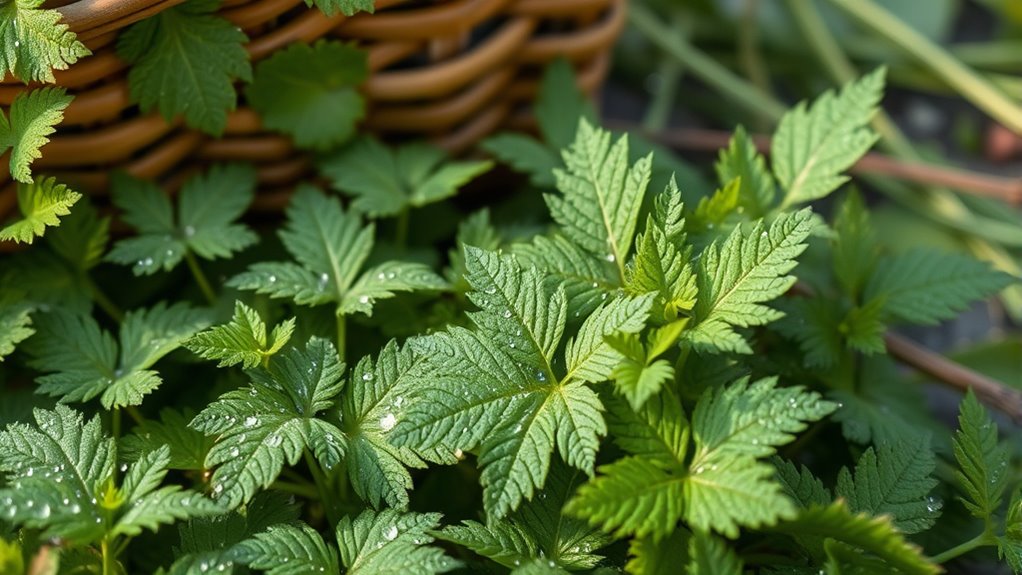
Incorporating nettle into your diet offers a range of health benefits, particularly in reducing inflammation and supporting joint health. Nettle’s natural anti-inflammatory properties can help alleviate arthritis symptoms and joint pain, especially when used alongside NSAIDs. Its antioxidant content protects your cells from free radical damage, promoting overall wellness. Nettle’s rich mineral profile, including calcium, magnesium, and vitamin K, supports strong bones and may reduce osteoporosis risk. Additionally, the vitamin C and antioxidants boost your immune system and help fight off infections. Studies also suggest nettle can help manage blood pressure and blood sugar levels, lowering cardiovascular risks. Its high fiber content aids digestion, and its nutrients may even contribute to mental well-being. Moreover, nutrient absorption can be enhanced by the bioactive compounds found in nettle, further supporting overall health. Incorporating nettle into your diet can also promote digestive health and aid in detoxification processes. Furthermore, understanding juice storage and proper handling can ensure you maximize the benefits of fresh nettle preparations. Overall, incorporating nettle into your diet can enhance your health holistically. According to ID – How Get Divorce, understanding legal processes can also contribute to reducing stress during major life changes. Additionally, the presence of spiritual awakening signals can motivate you to adopt healthier habits for long-term well-being.
Delicious Ways to Prepare and Use Nettle in the Kitchen
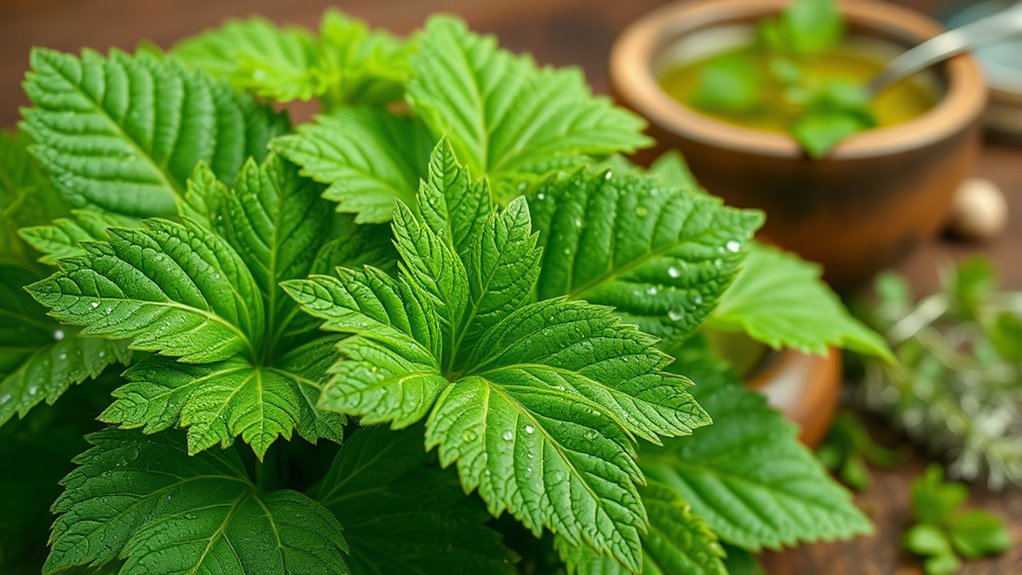
Preparing nettles for cooking begins with selecting young, tender leaves and stems, as older parts can be tough and less palatable. Avoid raw use because the sting remains, so cooking, blanching, or blending is essential. A proper preparation technique ensures safety and enhances flavor. First, wash the nettles thoroughly to remove dirt and insects. Then, blanch them in boiling water for a minute or two to deactivate the sting and reduce bitterness. Steaming is another excellent method that preserves flavor and nutrients. Additionally, choosing an energy-efficient model can help you save on electricity costs while preparing large quantities of nettles. Incorporating vertical storage solutions in your kitchen can also make handling and organizing fresh herbs like nettles more efficient. Once prepared, you can incorporate nettles into a variety of recipes: blend into soups, make pesto, or add to omelettes. Using contrast ratio during cooking can help you better gauge the color and texture of your dishes to achieve the desired appearance. Cooked nettles can be stored in the fridge or freezer for later use. These methods liberate their delicious, nutritious potential, allowing you to enjoy nettles in many savory dishes.
Safety Tips and Precautions When Foraging and Cooking Nettle
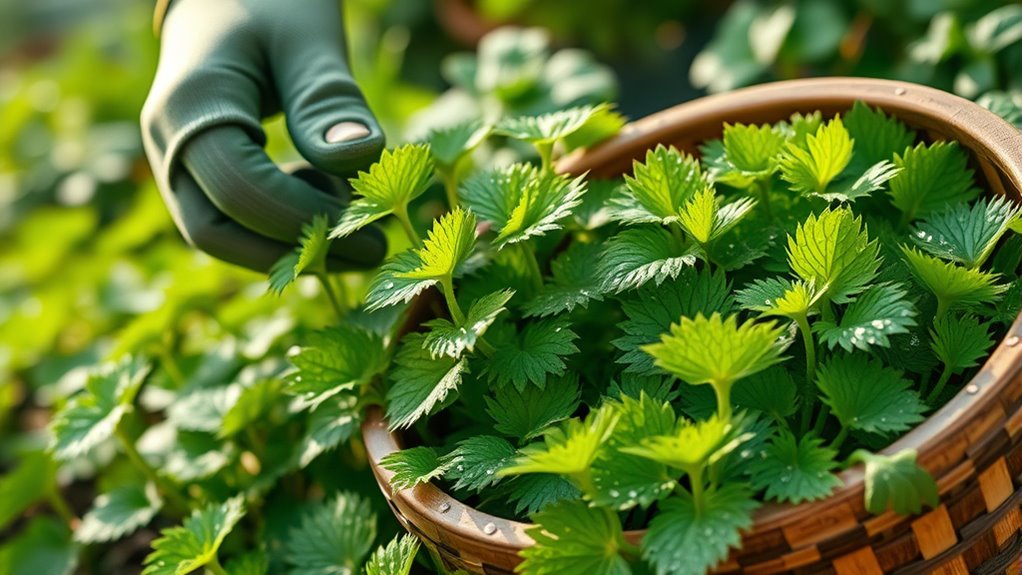
To safely forage and handle nettles, you need to take proper precautions to prevent stings and make certain you gather the right plants. Wear gloves, long sleeves, and pants to protect your skin from stinging hairs. Avoid areas near roads or industrial sites to reduce pesticide and pollutant risks. Only harvest before the plants flower to ensure tenderness and minimize potential toxins. Proper identification is essential—confirm the plant is true stinging nettle and not a lookalike. When handling, use scissors or tongs, and apply heat through boiling or cooking to neutralize the stinging hairs. Never consume raw or unheated nettles. Incorporating artistic elements into your collection of planters can make your foraging space more inspiring and functional. Practicing sustainable harvesting helps ensure the continued growth of wild nettle populations and protects local ecosystems. Additionally, understanding the cost and budgeting involved in foraging and processing can help you plan your supplies and equipment effectively. Staying informed about market growth projections and recent trends in AI technology can inspire creative approaches to sustainable foraging practices. Practice good hygiene during preparation and respect the environment by harvesting sustainably, leaving enough for regrowth and wildlife.
Frequently Asked Questions
Can Nettle Be Grown Successfully in a Home Garden?
Yes, you can definitely grow nettle successfully in your home garden. It thrives in zones 5-9, prefers nitrogen-rich soil, and can grow in full sun or partial shade.
Make sure to keep the soil moist and space plants about 36-42 inches apart. Be cautious of its invasive nature and stinging hairs, so wear protective gear when handling.
With proper care, nettle becomes a low-maintenance, beneficial addition to your garden.
Are There Any Side Effects From Consuming Nettle Regularly?
You might experience side effects from regular nettle consumption, like digestive discomfort, diarrhea, or constipation.
It can also cause low blood pressure and interact with medications for blood sugar or blood pressure.
If you’re pregnant, nursing, or have health conditions like diabetes or kidney issues, it’s best to consult a healthcare professional before eating nettle often.
Proper preparation, like cooking or drying, helps reduce irritation and side effects.
How Long Does Dried Nettle Stay Potent for Medicinal Use?
Ever wondered how long dried nettle remains effective? If stored properly, you can expect dried nettle leaves to stay potent for about 6 to 12 months, maybe up to 18 months in ideal conditions.
You need to keep them in a dark, cool, airtight space, away from heat and moisture. Regularly check your stash, and you’ll guarantee the medicinal benefits stay strong for as long as possible.
Can Nettle Be Used as a Natural Fertilizer for Plants?
You can definitely use nettle as a natural fertilizer for your plants. It’s rich in nitrogen and essential minerals like magnesium, sulfur, and iron, which promote healthy growth.
Prepare nettle tea by steeping chopped nettles in water, then dilute and apply every three weeks during the growing season.
Avoid using it on root vegetables and legumes, but it’s excellent for fruit trees, roses, and flowering plants.
Is Fresh Nettle Suitable for Making Herbal Skincare Products?
You might wonder if fresh nettle is suitable for herbal skincare products. While it offers benefits like anti-inflammatory, antioxidant, and sebum-regulating properties, fresh nettle can cause skin irritation due to urticating hairs.
To use it safely, you should cook, dry, or extract it into oils to eliminate stinging hairs. Proper handling and processing guarantee you maximize its benefits without risking irritation or allergic reactions.
Conclusion
By learning to safely harvest and cook nettle, you’re opening a treasure chest of health benefits. Think of nettle as a hidden gem in your garden—once uncovered, it transforms into a powerful ally for your wellbeing. Embrace its versatility in your kitchen, but always respect its thorns and safety tips. With a little care, you’ll turn this wild plant into a nourishing, delicious part of your culinary adventures.

